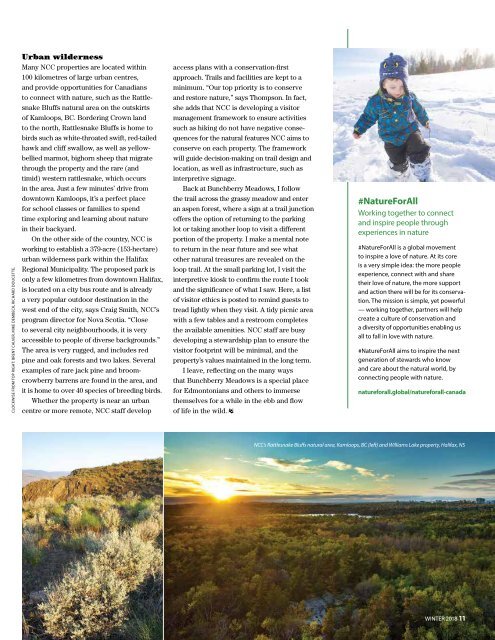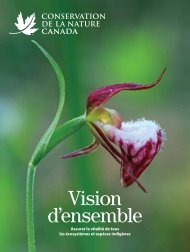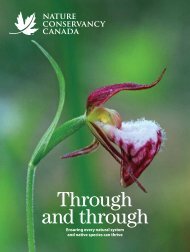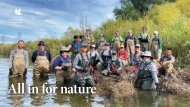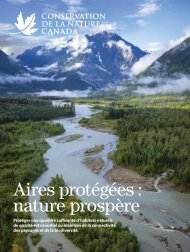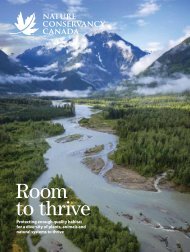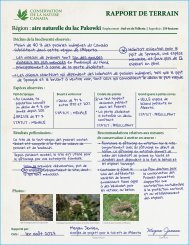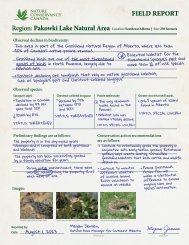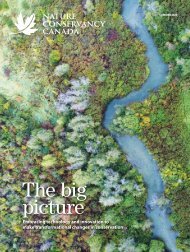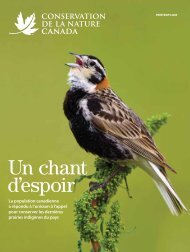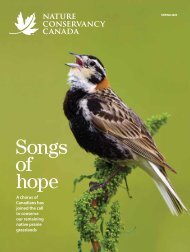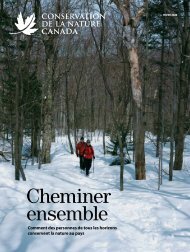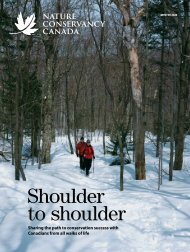Winter 2018 NCC magazine
Create successful ePaper yourself
Turn your PDF publications into a flip-book with our unique Google optimized e-Paper software.
CLOCKWISE FROM TOP RIGHT: BRENT CALVER, MIKE DEMBECK, RICHARD DOUCETTE.<br />
Urban wilderness<br />
Many <strong>NCC</strong> properties are located within<br />
100 kilometres of large urban centres,<br />
and provide opportunities for Canadians<br />
to connect with nature, such as the Rattlesnake<br />
Bluffs natural area on the outskirts<br />
of Kamloops, BC. Bordering Crown land<br />
to the north, Rattlesnake Bluffs is home to<br />
birds such as white-throated swift, red-tailed<br />
hawk and cliff swallow, as well as yellowbellied<br />
marmot, bighorn sheep that migrate<br />
through the property and the rare (and<br />
timid) western rattlesnake, which occurs<br />
in the area. Just a few minutes’ drive from<br />
downtown Kamloops, it’s a perfect place<br />
for school classes or families to spend<br />
time exploring and learning about nature<br />
in their backyard.<br />
On the other side of the country, <strong>NCC</strong> is<br />
working to establish a 379-acre (153-hectare)<br />
urban wilderness park within the Halifax<br />
Regional Municipality. The proposed park is<br />
only a few kilometres from downtown Halifax,<br />
is located on a city bus route and is already<br />
a very popular outdoor destination in the<br />
west end of the city, says Craig Smith, <strong>NCC</strong>’s<br />
program director for Nova Scotia. “Close<br />
to several city neighbourhoods, it is very<br />
accessible to people of diverse backgrounds.”<br />
The area is very rugged, and includes red<br />
pine and oak forests and two lakes. Several<br />
examples of rare jack pine and broomcrowberry<br />
barrens are found in the area, and<br />
it is home to over 40 species of breeding birds.<br />
Whether the property is near an urban<br />
centre or more remote, <strong>NCC</strong> staff develop<br />
access plans with a conservation-first<br />
approach. Trails and facilities are kept to a<br />
minimum. “Our top priority is to conserve<br />
and restore nature,” says Thompson. In fact,<br />
she adds that <strong>NCC</strong> is developing a visitor<br />
management framework to ensure activities<br />
such as hiking do not have negative consequences<br />
for the natural features <strong>NCC</strong> aims to<br />
conserve on each property. The framework<br />
will guide decision-making on trail design and<br />
location, as well as infrastructure, such as<br />
interpretive signage.<br />
Back at Bunchberry Meadows, I follow<br />
the trail across the grassy meadow and enter<br />
an aspen forest, where a sign at a trail junction<br />
offers the option of returning to the parking<br />
lot or taking another loop to visit a different<br />
portion of the property. I make a mental note<br />
to return in the near future and see what<br />
other natural treasures are revealed on the<br />
loop trail. At the small parking lot, I visit the<br />
interpretive kiosk to confirm the route I took<br />
and the significance of what I saw. Here, a list<br />
of visitor ethics is posted to remind guests to<br />
tread lightly when they visit. A tidy picnic area<br />
with a few tables and a restroom completes<br />
the available amenities. <strong>NCC</strong> staff are busy<br />
developing a stewardship plan to ensure the<br />
visitor footprint will be minimal, and the<br />
property’s values maintained in the long term.<br />
I leave, reflecting on the many ways<br />
that Bunchberry Meadows is a special place<br />
for Edmontonians and others to immerse<br />
themselves for a while in the ebb and flow<br />
of life in the wild.1<br />
#NatureForAll<br />
Working together to connect<br />
and inspire people through<br />
experiences in nature<br />
#NatureForAll is a global movement<br />
to inspire a love of nature. At its core<br />
is a very simple idea: the more people<br />
experience, connect with and share<br />
their love of nature, the more support<br />
and action there will be for its conservation.<br />
The mission is simple, yet powerful<br />
— working together, partners will help<br />
create a culture of conservation and<br />
a diversity of opportunities enabling us<br />
all to fall in love with nature.<br />
#NatureForAll aims to inspire the next<br />
generation of stewards who know<br />
and care about the natural world, by<br />
connecting people with nature.<br />
natureforall.global/natureforall-canada<br />
<strong>NCC</strong>’s Rattlesnake Bluffs natural area, Kamloops, BC (left) and Williams Lake property, Halifax, NS<br />
natureconservancy.ca<br />
WINTER <strong>2018</strong> 11


